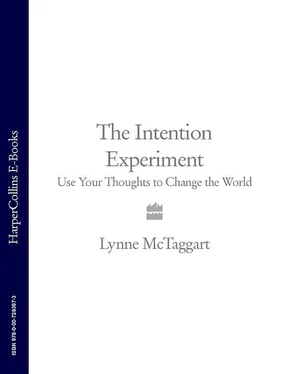All of classical physics, and indeed the rest of science, is derived from the laws of motion and gravity developed by Isaac Newton in his Principia , published in 1687. 2Newton’s laws described a universe in which all objects moved within the three-dimensional space of geometry and time according to certain fixed laws of motion. Matter was considered inviolate and self-contained, with its own fixed boundaries. Influence of any sort required something physical to be done to something else – a force or collision. Making something change basically entailed heating it, burning it, freezing it, dropping it or giving it a good swift kick.
Newtonian laws, science’s grand ‘rules of the game’, as the celebrated physicist Richard Feynman once referred to them, 3and their central premise, that things exist independently of each other, underpin our own philosophical view of the world. We believe that all of life and its tumultuous activity carries on around us, regardless of what we do or think. We sleep easy in our beds at night, in the certainty that when we close our eyes, the universe doesn’t disappear.
Nevertheless, that tidy view of the universe as a collection of isolated, well-behaved objects got dashed in the early part of the twentieth century, once the pioneers of quantum physics began peering closer into the heart of matter. The tiniest bits of the universe, those very things that make up the big, objective world, did not in any way behave themselves according to any rules that these scientists had ever known.
This outlaw behaviour was encapsulated in a collection of ideas that became known as the Copenhagen Interpretation, after ?the place where the forceful Danish physicist Niels Bohr and his brilliant protégé, the German physicist Werner Heisenberg, formulated the likely meaning of their extraordinary mathematical discoveries. Bohr and Heisenberg realized that atoms are not little solar systems of billiard balls but something far more messy: a tiny cloud of probability. Every subatomic particle is not a solid and stable thing, but exists simply as a potential of any one of its future selves – or what is known by physicists as a ‘superposition’, or sum, of all probabilities, like a person staring at himself in a hall of mirrors.
One of their conclusions concerned the notion of ‘indeterminacy’; that you can never know all there is to know about a subatomic particle all at the same time. If you discover information about where it is, for instance, you cannot work out at the same time exactly where it is going or at what speed. They spoke about a quantum particle as both a particle – a congealed, set thing – and a ‘wave function’ – a big smeared-out region of space and time, any corner of which the particle may occupy. It was akin to describing a person as comprising the entire street where he lives.
Their conclusions suggested that, at its most elemental, physical matter isn’t solid and stable – indeed, isn’t an anything yet. Subatomic reality did not resemble the solid and reliable state of being described to us by classical science, but an ephemeral prospect of seemingly infinite options. So capricious seemed the smallest bits of nature that the first quantum physicists had to make do with a crude symbolic approximation of the truth – a mathematical range of all possibility.
At the quantum level, reality resembled unset jelly.
The quantum theories developed by Bohr, Heisenberg and a host of others rocked the very foundation of the Newtonian view of matter as something discrete and self-contained. They suggested that matter, at its most fundamental, could not be divided into independently existing units and indeed could not even be fully described. Things had no meaning in isolation, but only in a web of dynamic interrelationship.
The quantum pioneers also discovered the astonishing ability of quantum particles to influence each other, despite the absence of all those usual things that physicists understand are responsible for influence, such as an exchange of force occurring at a finite velocity. Once in contact, particles retained an eerie remote hold over each other. The actions – for instance, the magnetic orientation – of one subatomic particle instantaneously influenced the other, no matter how far they were separated.
At the subatomic level, change also resulted through dynamic shifts of energy; these little packets of vibrating energy constantly traded energy back and forth to each other like ongoing passes in a game of basketball, a ceaseless to-ing and fro-ing that gave rise to an unfathomably large basic layer of energy in the universe. 4
Subatomic matter appeared to be involved in a continual exchange of information, causing constant refinement and subtle alteration. The universe was not a storehouse of static, separate objects, but a single organism of interconnected energy fields in a constant state of becoming. At its infinitesimal level, our world resembled a vast network of quantum information, with all its component parts constantly on the phone.
The only thing dissolving this little cloud of probability into something solid and measurable was the involvement of an observer. Once these scientists decided to have a closer look at a subatomic particle by taking a measurement, the subatomic entity that existed as pure potential would ‘collapse’ into one particular state.
The implications of these early experimental findings were profound: living consciousness somehow was the influence that turned the possibility of something into something real. The moment we looked at an electron or took a measurement, it appeared that we helped to determine its final state . This suggested that the most essential ingredient in creating our universe is the consciousness that observes it. Several of the central figures in quantum physics argued that the universe was democratic and participatory – a joint effort between observer and observed. 5
The observer effect in quantum experimentation gives rise to another heretical notion: that living consciousness is somehow central to this process of transforming the unconstructed quantum world into something resembling everyday reality. It suggests not only that the observer brings the observed into being, but also that nothing in the universe exists as an actual ‘thing’ independently of our perception of it.
It implies that observation – the very involvement of consciousness – gets the jelly to set.
It implies that reality is not fixed, but fluid, or mutable, and hence possibly open to influence .
The idea that consciousness creates and possibly even affects the physical universe also challenges our current scientific view of consciousness, which developed from the theories of the seventeenth-century philosopher René Descartes – mind is separate and somehow different from matter – and eventually embraced the notion that consciousness is entirely generated by the brain and remains locked up in the skull.
Most modern workaday physicists shrug their shoulders over this central conundrum: that big things are separate, but the tiny building blocks they are made up of are in instant and ceaseless communication with each other. For half a century, physicists have accepted, as though it makes perfect sense, that an electron behaving one way subatomically somehow transmutes into ‘classical’ (that is, Newtonian) behaviour once it realizes it is part of a larger whole.
In the main, scientists have stopped caring about the troublesome questions posed by quantum physics, and left unanswered by its earliest pioneers. Quantum theory works mathematically. It offers a highly successful recipe for dealing with the subatomic world. It helped to build atomic bombs and lasers, and to deconstruct the nature of the sun’s radiation. Today’s physicists have forgotten about the observer effect. They content themselves with their elegant equations and await the formulation of unified Theory of Everything or the discovery of a few more dimensions beyond the ones that ordinary humans perceive, which they hope will somehow pull together all these contradictory findings into one centralized theory.
Читать дальше











